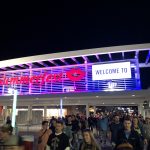“Code the Hoan” Program Launched
Light the Hoan education effort to help students learn how to program light shows on bridge, sync with music.
![Milwaukee's rivers flow out to Lake Michigan. Photo by Sulfur at English Wikipedia (Transferred from en.wikipedia to Commons.) [GFDL (http://www.gnu.org/copyleft/fdl.html) or CC-BY-SA-3.0 (http://creativecommons.org/licenses/by-sa/3.0/)], via Wikimedia Commons](https://urbanmilwaukee.com/wp-content/uploads/2017/12/1024px-Hoan_Bridge.jpg)
Milwaukee’s rivers flow out to Lake Michigan. Photo by Sulfur at English Wikipedia (CC-BY-SA-3.0)
Partners in the effort include the Milwaukee School of Engineering (MSOE), Islands of Brilliance, Boys & Girls Club of Greater Milwaukee, lighting provider Philips Signify, Discovery World, 88Nine Radio Milwaukee and SHARP Literacy.
Through a programming interface, students participating at the Boys & Girls Club, SHARP Literacy, Discovery World’s coding camps and MSOE’s “Girls Who Code” program will work on custom lighting options for the bridge. 88Nine will connect students with local musicians to enable their music to be synced with the student light shows. MSOE will also have a creative thinking class work on the lighting technology.
Philips installed test lights on the bridge for a week last November that flashed every time the Milwaukee Bucks scored during a game against the Boston Celtics. A demonstration was also run that showcased the color range and motion capabilities of the lights.
The Light the Hoan fundraising effort is led by Michael Hostad and Ian Abston. The Code the Hoan program announcement comes after project backers have repeatedly claimed the privately-funded project would have a civic impact beyond simply lighting the bridge.
“Code the Hoan has aligned and unified the STEM education community in Milwaukee in a unique way,” said Hostad in a release. “This project is about more than lights on a bridge and it is inspiring tech and coding talent because it brings coding to life in a beautiful, artistic and visible way for students and young people.” Hostad told Urban Milwaukee the organization hopes to make the Code the Hoan program as accessible as possible for students to participate.
The partnership drew praise from the lighting provider. “Though lighting projects like this are being completed in other major cities across the globe, never before have we seen this level of engagement with STEM education or enthusiasm about the project’s potential to inspire a generation of coders,” said Philips Signify vice president Jhawn Newman.
Funding at Halfway Point
The organization, which previously said the lighting could cost up to $5 million, announced a $1.2 million anonymous gift in November and said it had reached the halfway point in fundraising.
The bridge lighting partners reaffirmed their intention Tuesday to have the lights installed on the bridge by July 2020, in time for the Democratic National Convention.
Launched in late spring 2018, the group has announced “significant donations” from The Lacey Sadoff Foundation, the We Energies Foundation, the Milwaukee Bucks, the Herzfeld Foundation, MillerCoors and Concurrency. Over 1,600 contributions have been made through a crowdfunding campaign designed to show community interest.
“Milwaukee is getting national and global attention for the incredible things going on in this city, and we see a tremendous opportunity to follow the lead of other cities that have experienced the economic benefits of urban lighting projects,” said Abston in November. “What we envisioned three years ago is rapidly becoming a reality, and we couldn’t be more excited to build on this momentum with a project that truly reflects our generation and our community.”
Built between 1970 and 1972, the Hoan Bridge is nearly two miles in length. It opened to the public in 1977, after being derided as the “Bridge to Nowhere” for five years.
If you think stories like this are important, become a member of Urban Milwaukee and help support real, independent journalism. Plus you get some cool added benefits.
Eyes on Milwaukee
-
Church, Cupid Partner On Affordable Housing
 Dec 4th, 2023 by Jeramey Jannene
Dec 4th, 2023 by Jeramey Jannene
-
Downtown Building Sells For Nearly Twice Its Assessed Value
 Nov 12th, 2023 by Jeramey Jannene
Nov 12th, 2023 by Jeramey Jannene
-
Immigration Office Moving To 310W Building
 Oct 25th, 2023 by Jeramey Jannene
Oct 25th, 2023 by Jeramey Jannene





















